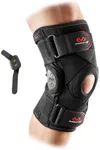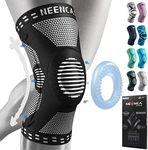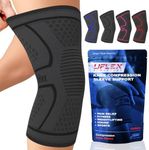Buying Guide for the Best Skiing Knee Brace
Choosing the right knee brace for skiing is important to ensure both comfort and protection on the slopes. A good knee brace can help prevent injuries, provide support if you have a previous knee issue, and give you confidence while skiing. When shopping for a knee brace, it's important to consider your specific needs, such as whether you need it for injury prevention, mild support, or post-injury recovery. Understanding the key features will help you make a choice that matches your activity level and comfort preferences.Support LevelSupport level refers to how much stability and protection the knee brace provides. This is important because different people need different levels of support depending on their knee health and skiing style. Light support braces are usually sleeves that offer compression and warmth, suitable for mild discomfort or prevention. Moderate support braces may have additional straps or hinges, ideal for those with minor injuries or instability. Maximum support braces are often rigid with strong hinges, designed for people recovering from serious injuries or surgeries. To pick the right one, think about your knee's condition: if you have no injuries, light support may be enough; for mild pain or instability, go for moderate; and for post-injury or high-risk situations, choose maximum support.
Fit and ComfortFit and comfort describe how well the brace sits on your knee and how comfortable it feels during movement. This is crucial because a poorly fitting brace can slip, cause discomfort, or even restrict your movement on the slopes. Braces come in different sizes and designs, from slip-on sleeves to wrap-around styles with adjustable straps. Some are bulkier, while others are slim and low-profile. To find the best fit, measure your knee as recommended by the manufacturer and consider whether you’ll wear the brace under ski pants. If you ski for long hours, prioritize comfort and breathability.
Material and BreathabilityMaterial and breathability refer to what the brace is made of and how well it allows air to circulate. This matters because skiing is an active sport, and you want a brace that won’t make your knee sweaty or irritated. Common materials include neoprene, which is warm and supportive but less breathable, and mesh or fabric blends, which are lighter and allow more airflow. If you ski in cold conditions, a warmer material might be fine, but for long or intense sessions, look for breathable fabrics to keep your skin comfortable.
Mobility and FlexibilityMobility and flexibility indicate how much the brace allows your knee to move naturally. This is important because skiing requires bending, turning, and quick movements. Some braces are very rigid for maximum protection, but they can limit your range of motion. Others are more flexible, allowing for easier movement but offering less support. If you need strong protection, be prepared for some restriction; if you value freedom of movement, choose a more flexible brace. Match your choice to your skiing style and how much support you need.
Ease of UseEase of use means how simple it is to put on, adjust, and take off the knee brace. This is important because you may need to adjust your brace quickly on the slopes or while wearing gloves. Some braces have simple slip-on designs, while others use Velcro straps or buckles for a more customized fit. If you want convenience, look for a brace that’s easy to handle and adjust, especially if you plan to take it on and off during your ski day.












![Knee Support Brace Compression Sleeves for Men and Women (Black) (Pair) [3XL] - for Ligament Injury, Joint Pain Relief, Running, Arthritis, ACL, MCL, Sport](https://images-proxy.bestreviews.guide/ihbQP-kgiCHhEZVGLYmMrxbPi1k=/0x150/https://m.media-amazon.com/images/I/41dRssPJpTL._AC_CX679_.jpg)
